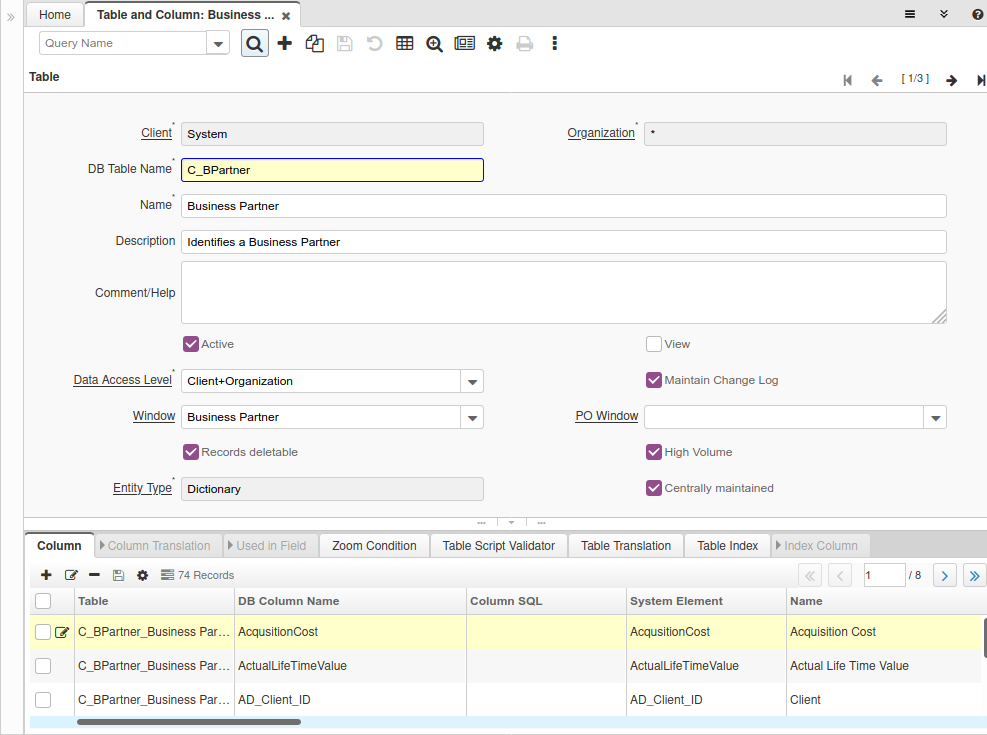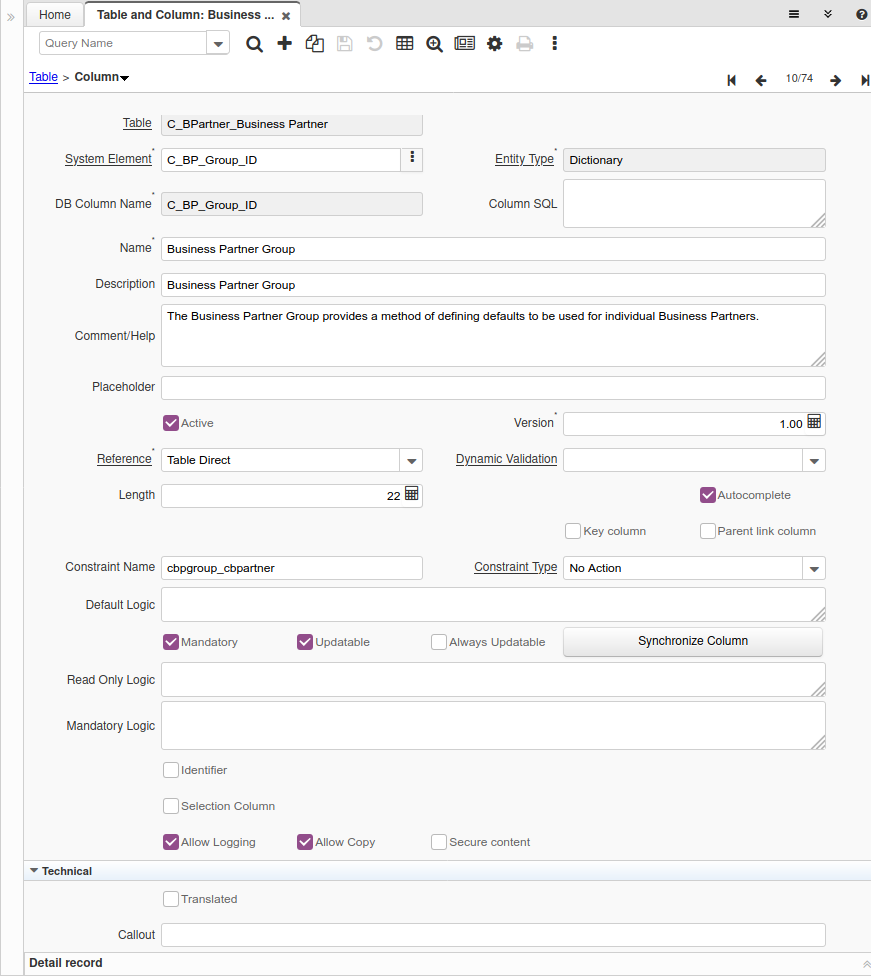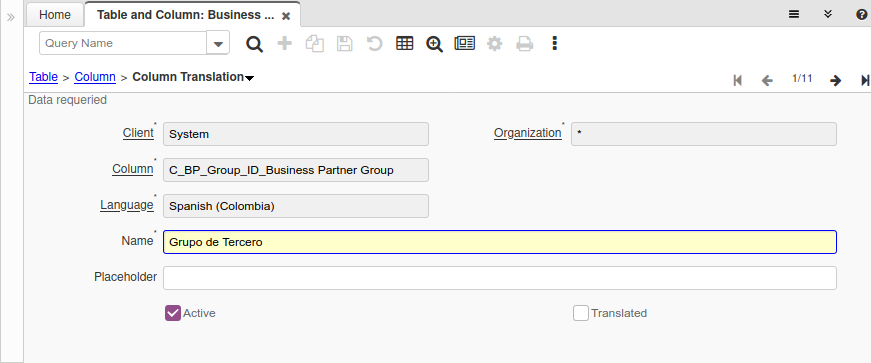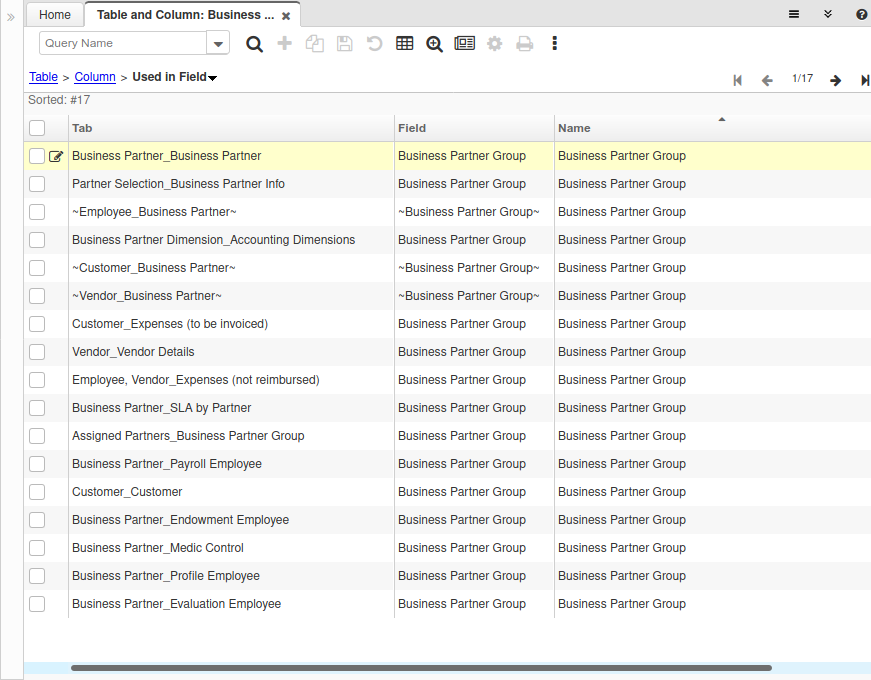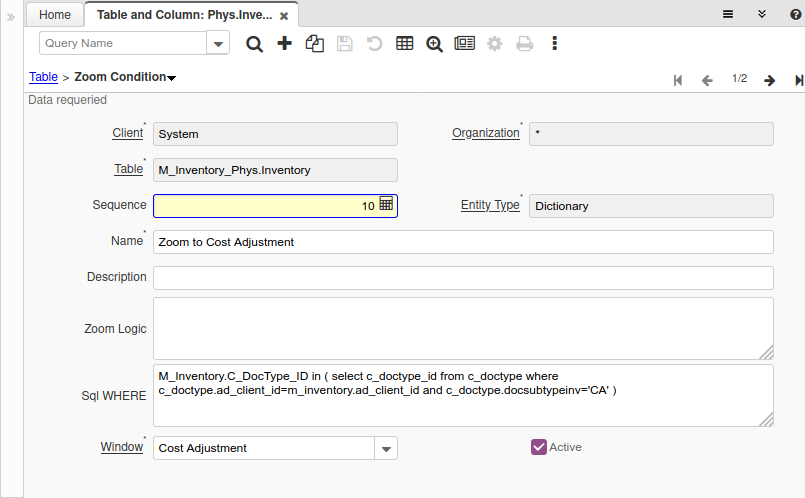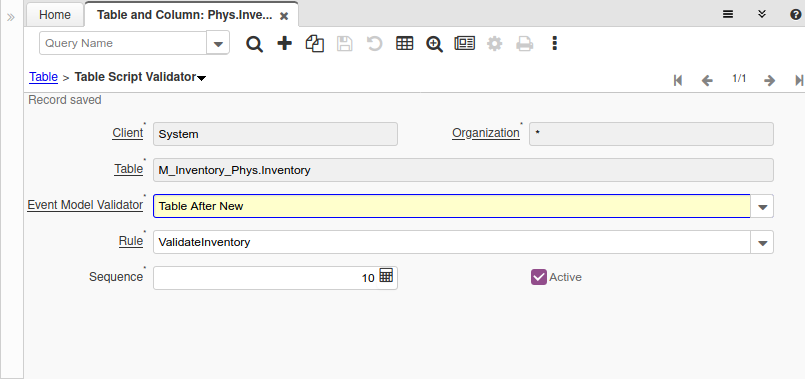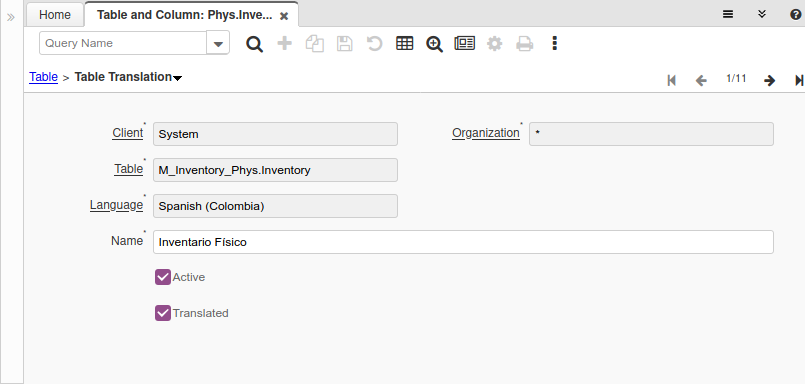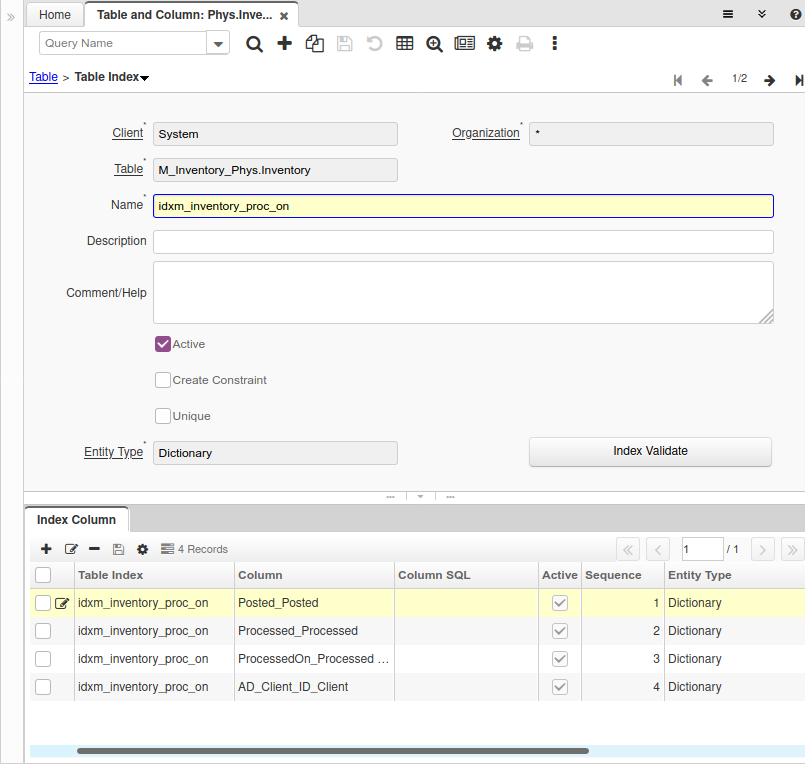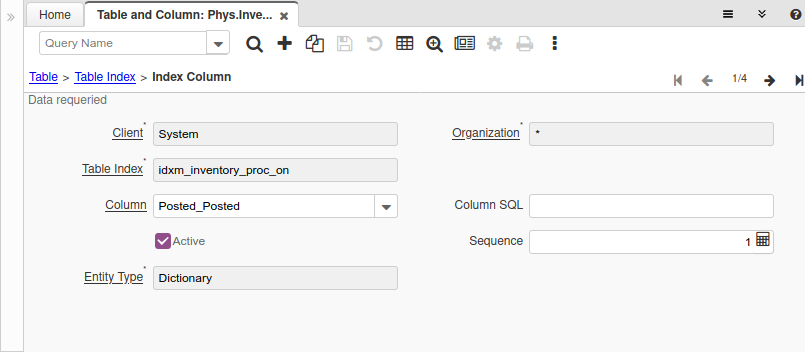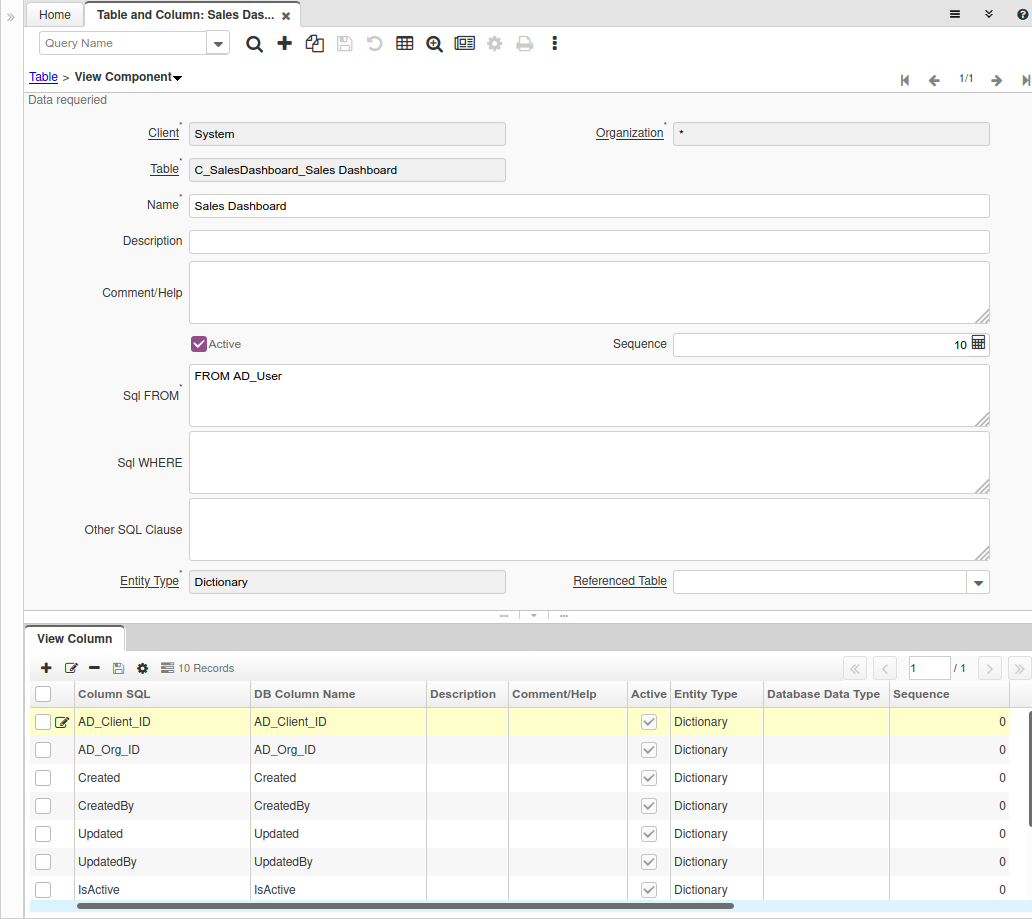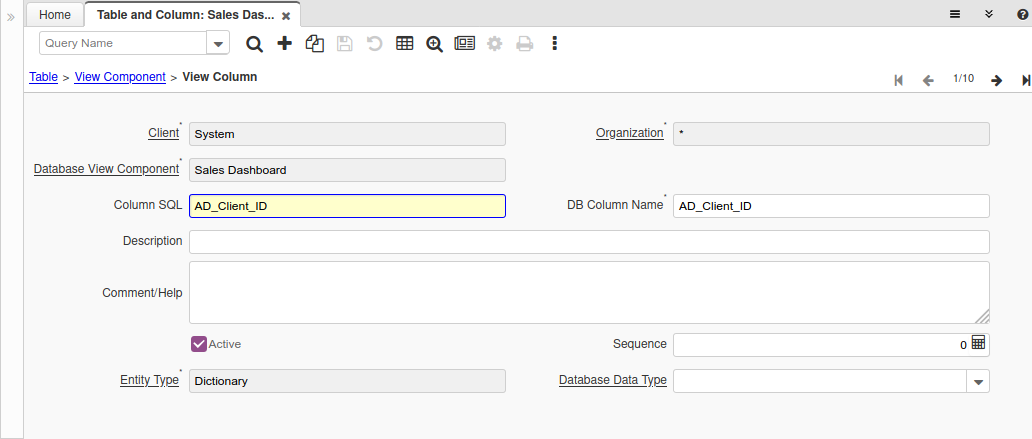Table and Column (Window ID-100)
Window: Table and Column
Description: Maintain Tables and Columns
Help: The Table and Column Window defines all tables with their columns
Tab: Table
Description: Table definitions
Help: Table (header) definition - Note that the name of most tables is automatically synchronized.
| Name | Description | Help | Technical Data |
|---|---|---|---|
| Tenant | Tenant for this installation. | A Tenant is a company or a legal entity. You cannot share data between Tenants. | AD_Table.AD_Client_ID numeric(10) Table Direct |
| Organization | Organizational entity within tenant | An organization is a unit of your tenant or legal entity - examples are store, department. You can share data between organizations. | AD_Table.AD_Org_ID numeric(10) Table Direct |
| DB Table Name | Name of the table in the database | The DB Table Name indicates the name of the table in database. | AD_Table.TableName character varying(60) String |
| Name | Alphanumeric identifier of the entity | The name of an entity (record) is used as an default search option in addition to the search key. The name is up to 60 characters in length. | AD_Table.Name character varying(60) String |
| Description | Optional short description of the record | A description is limited to 255 characters. | AD_Table.Description character varying(255) String |
| Comment/Help | Comment or Hint | The Help field contains a hint, comment or help about the use of this item. | AD_Table.Help character varying(2000) Text |
| Active | The record is active in the system | There are two methods of making records unavailable in the system: One is to delete the record, the other is to de-activate the record. A de-activated record is not available for selection, but available for reports.
There are two reasons for de-activating and not deleting records: (1) The system requires the record for audit purposes. (2) The record is referenced by other records. E.g., you cannot delete a Business Partner, if there are invoices for this partner record existing. You de-activate the Business Partner and prevent that this record is used for future entries. |
AD_Table.IsActive character(1) Yes-No |
| View | This is a view | This is a view rather than a table. A view is always treated as read only in the system. | AD_Table.IsView character(1) Yes-No |
| Data Access Level | Access Level required | Indicates the access level required for this record or process. | AD_Table.AccessLevel character(1) List |
| Maintain Change Log | Maintain a log of changes | If selected, a log of all changes is maintained. | AD_Table.IsChangeLog character(1) Yes-No |
| Replication Type | Type of Data Replication | The Type of data Replication determines the direction of the data replication. Reference means that the data in this system is read only -> |
AD_Table.ReplicationType character(1) List |
| Window | Data entry or display window | The Window field identifies a unique Window in the system. | AD_Table.AD_Window_ID numeric(10) Table Direct |
| PO Window | Purchase Order Window | Window for Purchase Order (AP) Zooms | AD_Table.PO_Window_ID numeric(10) Table |
| Records deletable | Indicates if records can be deleted from the database | The Records Deletable checkbox indicates if a record can be deleted from the database. If records cannot be deleted, you can only deselect the Active flag | AD_Table.IsDeleteable character(1) Yes-No |
| High Volume | Use Search instead of Pick list | The High Volume Checkbox indicates if a search screen will display as opposed to a pick list for selecting records from this table. | AD_Table.IsHighVolume character(1) Yes-No |
| Entity Type | Dictionary Entity Type; Determines ownership and synchronization | The Entity Types "Dictionary", "iDempiere" and "Application" might be automatically synchronized and customizations deleted or overwritten.
For customizations, copy the entity and select "User"! |
AD_Table.EntityType character varying(40) Table |
| Create Columns from DB | Create Dictionary Columns of Table not existing as a Column but in the Database | If you have added columns in the database to this table, this procedure creates the Column records in the Dictionary. Please be aware, that they may deleted, if the entity type is not set to User. | AD_Table.ImportTable character(1) Button |
| Copy Columns from Table | Create Dictionary Columns for a Table taking another as base | AD_Table.CopyColumnsFromTable character varying(1) Button | |
| Centrally maintained | Information maintained in System Element table | The Centrally Maintained checkbox indicates if the Name, Description and Help maintained in 'System Element' table or 'Window' table. | AD_Table.IsCentrallyMaintained character(1) Yes-No |
| View Validate | AD_Table.Processing character(1) Button | ||
| Drop view | AD_Table.DatabaseViewDrop character(1) Button | ||
| Copy Components From View | Create dictionary view components for a table taking another as base | AD_Table.CopyComponentsFromView character(1) Button | |
| Create Window, Tab and Field from Table | Create Window, Tab and Field record of the Table | This process will take the table definition and create the Window/Tab and field record with these options: New Window: if selected the process will create a new Window record. Otherwise, the process will create a new tab and add it to the selected window. |
AD_Table.CreateWindowFromTable character(1) Button |
| Show In Drill Options | This parameter enables the table to be displayed in Drill Assistant - Table tab | AD_Table.IsShowInDrillOptions character(1) Yes-No | |
| Partition | This is a partitioned table | AD_Table.IsPartition character(1) Yes-No | |
| Create/Update Table Partition | Process which create or update table partitions based on the table and column records | The Create/update partition process will create or update table partitions based on the information in the table and column records | AD_Table.CreatePartition character(1) Button |
Tab: Column
Description: Table Column definitions
Help: Defines the columns of a table. Note that the name of the column is automatically synchronized.
| Name | Description | Help | Technical Data |
|---|---|---|---|
| Tenant | Tenant for this installation. | A Tenant is a company or a legal entity. You cannot share data between Tenants. | AD_Column.AD_Client_ID numeric(10) Table Direct |
| Organization | Organizational entity within tenant | An organization is a unit of your tenant or legal entity - examples are store, department. You can share data between organizations. | AD_Column.AD_Org_ID numeric(10) Table Direct |
| Table | Database Table information | The Database Table provides the information of the table definition | AD_Column.AD_Table_ID numeric(10) Table Direct |
| System Element | System Element enables the central maintenance of column description and help. | The System Element allows for the central maintenance of help, descriptions and terminology for a database column. | AD_Column.AD_Element_ID numeric(10) Search |
| Entity Type | Dictionary Entity Type; Determines ownership and synchronization | The Entity Types "Dictionary", "iDempiere" and "Application" might be automatically synchronized and customizations deleted or overwritten.
For customizations, copy the entity and select "User"! |
AD_Column.EntityType character varying(40) Table |
| DB Column Name | Name of the column in the database | The Column Name indicates the name of a column on a table as defined in the database. | AD_Column.ColumnName character varying(63) String |
| Column SQL | Virtual Column (r/o) | You can define virtual columns (not stored in the database). If defined, the Column name is the synonym of the SQL expression defined here. The SQL expression must be valid. Example: "Updated-Created" would list the age of the entry in days. |
AD_Column.ColumnSQL character varying(4000) String |
| Name | Alphanumeric identifier of the entity | The name of an entity (record) is used as an default search option in addition to the search key. The name is up to 60 characters in length. | AD_Column.Name character varying(60) String |
| Description | Optional short description of the record | A description is limited to 255 characters. | AD_Column.Description character varying(255) String |
| Comment/Help | Comment or Hint | The Help field contains a hint, comment or help about the use of this item. | AD_Column.Help character varying(2000) Text |
| Placeholder | AD_Column.Placeholder character varying(255) String | ||
| Active | The record is active in the system | There are two methods of making records unavailable in the system: One is to delete the record, the other is to de-activate the record. A de-activated record is not available for selection, but available for reports.
There are two reasons for de-activating and not deleting records: (1) The system requires the record for audit purposes. (2) The record is referenced by other records. E.g., you cannot delete a Business Partner, if there are invoices for this partner record existing. You de-activate the Business Partner and prevent that this record is used for future entries. |
AD_Column.IsActive character(1) Yes-No |
| Version | Version of the table definition | The Version indicates the version of this table definition. | AD_Column.Version numeric Amount |
| Reference | System Reference and Validation | The Reference could be a display type, list or table validation. | AD_Column.AD_Reference_ID numeric(10) Table |
| Dynamic Validation | Dynamic Validation Rule | These rules define how an entry is determined to valid. You can use variables for dynamic (context sensitive) validation. | AD_Column.AD_Val_Rule_ID numeric(10) Table Direct |
| Length | Length of the column in the database | The Length indicates the length of a column as defined in the database. | AD_Column.FieldLength numeric(10) Integer |
| Dynamic Validation (Lookup) | Override Dynamic Validation Rule for Lookup Window | For some situations the dynamic validation rule for a Lookup window should be different from user data entry window. | AD_Column.AD_Val_Rule_Lookup_ID numeric(10) Table |
| HTML | Text has HTML tags | AD_Column.IsHtml character(1) Yes-No | |
| Auto complete | Automatic completion for text fields | The autocompletion uses all existing values (from the same tenant and organization) of the field. | AD_Column.IsAutocomplete character(1) Yes-No |
| Format Pattern | The pattern used to format a number or date. | A string complying with either Java SimpleDateFormat or DecimalFormat pattern syntax used to override the default presentation format of a date or number type field. | AD_Column.FormatPattern character varying(22) String |
| Value Format | Format of the value; Can contain fixed format elements, Variables: "_lLoOaAcCa09", or ~regex | Validation elements:
~regex - Validates a regular expression (Space) any character _ Space (fixed character) l any Letter a..Z NO space L any Letter a..Z NO space converted to upper case o any Letter a..Z or space O any Letter a..Z or space converted to upper case a any Letters & Digits NO space A any Letters & Digits NO space converted to upper case c any Letters & Digits or space C any Letters & Digits or space converted to upper case 0 Digits 0..9 NO space 9 Digits 0..9 or space Example of format "(000)_000-0000" |
AD_Column.VFormat character varying(255) String |
| Process | Process or Report | The Process field identifies a unique Process or Report in the system. | AD_Column.AD_Process_ID numeric(10) Table Direct |
| Info Window | Info and search/select Window | The Info window is used to search and select records as well as display information relevant to the selection. | AD_Column.AD_InfoWindow_ID numeric(10) Table Direct |
| Chart | AD_Column.AD_Chart_ID numeric(10) Table Direct | ||
| Dashboard Content | AD_Column.PA_DashboardContent_ID numeric(10) Table Direct | ||
| Reference Key | Required to specify, if data type is Table or List | The Reference Value indicates where the reference values are stored. It must be specified if the data type is Table or List. | AD_Column.AD_Reference_Value_ID numeric(10) Table |
| Min. Value | Minimum Value for a field | The Minimum Value indicates the lowest allowable value for a field. use format yyyy-mm-dd for Date | AD_Column.ValueMin character varying(20) String |
| Max. Value | Maximum Value for a field | The Maximum Value indicates the highest allowable value for a field. use format yyyy-mm-dd for Date | AD_Column.ValueMax character varying(20) String |
| Key column | This column is the key in this table | The key column must also be display sequence 0 in the field definition and may be hidden. | AD_Column.IsKey character(1) Yes-No |
| Parent link column | This column is a link to the parent table (e.g. header from lines) - incl. Association key columns | The Parent checkbox indicates if this column is a link to the parent table. | AD_Column.IsParent character(1) Yes-No |
| Constraint Name | AD_Column.FKConstraintName character varying(63) String | ||
| Constraint Type | AD_Column.FKConstraintType character(1) List | ||
| Constraint Message | AD_Column.FKConstraintMsg_ID numeric(10) Search | ||
| Default Logic | Default value hierarchy, separated by ; | The defaults are evaluated in the order of definition, the first not null value becomes the default value of the column. The values are separated by comma or semicolon. a) Literals:. 'Text' or 123 b) Variables - in format @Variable@ - Login e.g. #Date, #AD_Org_ID, #AD_Tenant_ID - Accounting Schema: e.g. , - Global defaults: e.g. DateFormat - Window values (all Picks, CheckBoxes, RadioButtons, and DateDoc/DateAcct) c) SQL code with the tag: @SQL=SELECT something AS DefaultValue FROM ... The SQL statement can contain variables. There can be no other value other than the SQL statement. The default is only evaluated, if no user preference is defined. Default definitions are ignored for record columns as Key, Parent, Tenant as well as Buttons. | AD_Column.DefaultValue character varying(2000) Text |
| Mandatory | Data entry is required in this column | The field must have a value for the record to be saved to the database. | AD_Column.IsMandatory character(1) Yes-No |
| Updatable | Determines, if the field can be updated | The Updatable checkbox indicates if a field can be updated by the user. | AD_Column.IsUpdateable character(1) Yes-No |
| Always Updatable | The column is always updateable, even if the record is not active or processed | If selected and if the window / tab is not read only, you can always update the column. This might be useful for comments, etc. | AD_Column.IsAlwaysUpdateable character(1) Yes-No |
| Synchronize Column | Change database table definition from application dictionary | When selected, the database column definition is updated based on your entries in the Column definition of the Application Dictionary. Note that not all changes are supported by the database and may result in an error. | AD_Column.IsSyncDatabase character(1) Button |
| Always Updatable Logic | Logic to determine if field is Updatable irrespective if record's active status or processed status. This logic Applicable only if Always Updatable is N. | format := {expression} [{logic} {expression}] expression := @{context}@{operand}{value} or @{context}@{operand}{value}
Strings may be in single quotes (optional) |
AD_Column.AlwaysUpdatableLogic character varying(2000) Text |
| Column Encryption | Test and enable Column Encryption | To enable storage encryption or remove encryption is dangerous as you may loose data. You need to verify that the column is big enough to hold the encrypted value. You can provide your own encryption method, but cannot change it once enabled. The default implementation supports US ASCII String conversion (not Unicode, Numbers, Dates) |
AD_Column.IsEncrypted character(1) Button |
| Read Only Logic | Logic to determine if field is read only (applies only when field is read-write) | format := {expression} [{logic} {expression}] expression := @{context}@{operand}{value} or @{context}@{operand}{value}
Strings may be in single quotes (optional) |
AD_Column.ReadOnlyLogic character varying(2000) Text |
| Mandatory Logic | AD_Column.MandatoryLogic character varying(2000) Text | ||
| Identifier | This column is part of the record identifier | The Identifier checkbox indicates that this column is part of the identifier or key for this table. | AD_Column.IsIdentifier character(1) Yes-No |
| Sequence | Method of ordering records; lowest number comes first | The Sequence indicates the order of records | AD_Column.SeqNo numeric(10) Integer |
| Selection Column | Is this column used for finding rows in windows | If selected, the column is listed in the first find window tab and in the selection part of the window | AD_Column.IsSelectionColumn character(1) Yes-No |
| Selection Column Sequence | Selection Column Sequence | For ordering sequence of selection column | AD_Column.SeqNoSelection numeric(10) Integer |
| Allow Logging | Determine if a column must be recorded into the change log | AD_Column.IsAllowLogging character(1) Yes-No | |
| Allow Copy | Determine if a column must be copied when pushing the button to copy record | AD_Column.IsAllowCopy character(1) Yes-No | |
| Secure content | Defines whether content must be treated as secure | AD_Column.IsSecure character(1) Yes-No | |
| Toolbar Button | Show the button on the toolbar, the window, or both | The IsToolbarButton field indicates if this button is part of the toolbar's process button popup list, or render as field in window, or both. | AD_Column.IsToolbarButton character(1) List |
| Translated | This column is translated | The Translated checkbox indicates if this column is translated. | AD_Column.IsTranslated character(1) Yes-No |
| Callout | Fully qualified class names and method - separated by semicolons | A Callout allow you to create Java extensions to perform certain tasks always after a value changed. Callouts should not be used for validation but consequences of a user selecting a certain value.
The callout is a Java class implementing org.compiere.model.Callout and a method name to call. Example: "org.compiere.model.CalloutRequest.copyText" instantiates the class "CalloutRequest" and calls the method "copyText". You can have multiple callouts by separating them via a semicolon |
AD_Column.Callout character varying(255) String |
| Partition Key | This is a partition key | AD_Column.IsPartitionKey character(1) Yes-No | |
| Partition Key Sequence | Indicates the order of partition keys | The Partition Key Sequence indicates the order of the partition keys where the lowest number comes first | AD_Column.SeqNoPartition numeric(10) Integer |
| Partitioning Method | Indicates how the Table is partitioned | The Partitioning Method indicates how the Table is partitioned (List or Range). List partitioning - The data distribution is defined by a discrete list of values. Range Partitioning - The data is distributed based on a range of values. | AD_Column.PartitioningMethod character varying(2) List |
| Range Partition Interval | Indicates the interval used in a range partitioning | The Range Partition Interval indicates the interval used in a range partitioning (date or number). Examples of date intervals: 1 year; 6 months; Examples of number intervals: 5000; 100000; | AD_Column.RangePartitionInterval character varying(30) String |
Tab: Column Translation
Description: Column Translation
Help: Do not translate - overwritten / translated automatically
| Name | Description | Help | Technical Data |
|---|---|---|---|
| Tenant | Tenant for this installation. | A Tenant is a company or a legal entity. You cannot share data between Tenants. | AD_Column_Trl.AD_Client_ID numeric(10) Table Direct |
| Organization | Organizational entity within tenant | An organization is a unit of your tenant or legal entity - examples are store, department. You can share data between organizations. | AD_Column_Trl.AD_Org_ID numeric(10) Table Direct |
| Column | Column in the table | Link to the database column of the table | AD_Column_Trl.AD_Column_ID numeric(10) Table Direct |
| Language | Language for this entity | The Language identifies the language to use for display and formatting | AD_Column_Trl.AD_Language character varying(6) Table |
| Name | Alphanumeric identifier of the entity | The name of an entity (record) is used as an default search option in addition to the search key. The name is up to 60 characters in length. | AD_Column_Trl.Name character varying(60) String |
| Placeholder | AD_Column_Trl.Placeholder character varying(255) String | ||
| Active | The record is active in the system | There are two methods of making records unavailable in the system: One is to delete the record, the other is to de-activate the record. A de-activated record is not available for selection, but available for reports.
There are two reasons for de-activating and not deleting records: (1) The system requires the record for audit purposes. (2) The record is referenced by other records. E.g., you cannot delete a Business Partner, if there are invoices for this partner record existing. You de-activate the Business Partner and prevent that this record is used for future entries. |
AD_Column_Trl.IsActive character(1) Yes-No |
| Translated | This column is translated | The Translated checkbox indicates if this column is translated. | AD_Column_Trl.IsTranslated character(1) Yes-No |
Tab: Used in Field
Description:
Help:
| Name | Description | Help | Technical Data |
|---|---|---|---|
| Tab | Tab within a Window | The Tab indicates a tab that displays within a window. | AD_Field.AD_Tab_ID numeric(10) Table Direct |
| Field | Field on a database table | The Field identifies a field on a database table. | AD_Field.AD_Field_ID numeric(10) ID |
| Name | Alphanumeric identifier of the entity | The name of an entity (record) is used as an default search option in addition to the search key. The name is up to 60 characters in length. | AD_Field.Name character varying(60) String |
Tab: Zoom Condition
Description:
Help:
| Name | Description | Help | Technical Data |
|---|---|---|---|
| Tenant | Tenant for this installation. | A Tenant is a company or a legal entity. You cannot share data between Tenants. | AD_ZoomCondition.AD_Client_ID numeric(10) Table Direct |
| Organization | Organizational entity within tenant | An organization is a unit of your tenant or legal entity - examples are store, department. You can share data between organizations. | AD_ZoomCondition.AD_Org_ID numeric(10) Table Direct |
| Table | Database Table information | The Database Table provides the information of the table definition | AD_ZoomCondition.AD_Table_ID numeric(10) Table Direct |
| Sequence | Method of ordering records; lowest number comes first | The Sequence indicates the order of records | AD_ZoomCondition.SeqNo numeric(10) Integer |
| Entity Type | Dictionary Entity Type; Determines ownership and synchronization | The Entity Types "Dictionary", "iDempiere" and "Application" might be automatically synchronized and customizations deleted or overwritten.
For customizations, copy the entity and select "User"! |
AD_ZoomCondition.EntityType character varying(40) Table |
| Name | Alphanumeric identifier of the entity | The name of an entity (record) is used as an default search option in addition to the search key. The name is up to 60 characters in length. | AD_ZoomCondition.Name character varying(60) String |
| Description | Optional short description of the record | A description is limited to 255 characters. | AD_ZoomCondition.Description character varying(255) String |
| Zoom Logic | the result determines if the zoom condition is applied | format := {expression} [{logic} {expression}] expression := @{context}@{operand}{value} or @{context}@{operand}{value}
Strings may be in single quotes (optional) |
AD_ZoomCondition.ZoomLogic character varying(2000) Text |
| Sql WHERE | Fully qualified SQL WHERE clause | The Where Clause indicates the SQL WHERE clause to use for record selection. The WHERE clause is added to the query. Fully qualified means "tablename.columnname". | AD_ZoomCondition.WhereClause character varying(2000) Text |
| Window | Data entry or display window | The Window field identifies a unique Window in the system. | AD_ZoomCondition.AD_Window_ID numeric(10) Table Direct |
| Active | The record is active in the system | There are two methods of making records unavailable in the system: One is to delete the record, the other is to de-activate the record. A de-activated record is not available for selection, but available for reports.
There are two reasons for de-activating and not deleting records: (1) The system requires the record for audit purposes. (2) The record is referenced by other records. E.g., you cannot delete a Business Partner, if there are invoices for this partner record existing. You de-activate the Business Partner and prevent that this record is used for future entries. |
AD_ZoomCondition.IsActive character(1) Yes-No |
Tab: Table Script Validator
Description:
Help:
| Name | Description | Help | Technical Data |
|---|---|---|---|
| Tenant | Tenant for this installation. | A Tenant is a company or a legal entity. You cannot share data between Tenants. | AD_Table_ScriptValidator.AD_Client_ID numeric(10) Table Direct |
| Organization | Organizational entity within tenant | An organization is a unit of your tenant or legal entity - examples are store, department. You can share data between organizations. | AD_Table_ScriptValidator.AD_Org_ID numeric(10) Table Direct |
| Table | Database Table information | The Database Table provides the information of the table definition | AD_Table_ScriptValidator.AD_Table_ID numeric(10) Table Direct |
| Event Model Validator | AD_Table_ScriptValidator.EventModelValidator character varying(4) List | ||
| Rule | AD_Table_ScriptValidator.AD_Rule_ID numeric(10) Table Direct | ||
| Sequence | Method of ordering records; lowest number comes first | The Sequence indicates the order of records | AD_Table_ScriptValidator.SeqNo numeric(10) Integer |
| Active | The record is active in the system | There are two methods of making records unavailable in the system: One is to delete the record, the other is to de-activate the record. A de-activated record is not available for selection, but available for reports.
There are two reasons for de-activating and not deleting records: (1) The system requires the record for audit purposes. (2) The record is referenced by other records. E.g., you cannot delete a Business Partner, if there are invoices for this partner record existing. You de-activate the Business Partner and prevent that this record is used for future entries. |
AD_Table_ScriptValidator.IsActive character(1) Yes-No |
Tab: Table Translation
Description: Table Translation
Help: Note that many Table names will be overwritten / translated automatically
| Name | Description | Help | Technical Data |
|---|---|---|---|
| Tenant | Tenant for this installation. | A Tenant is a company or a legal entity. You cannot share data between Tenants. | AD_Table_Trl.AD_Client_ID numeric(10) Table Direct |
| Organization | Organizational entity within tenant | An organization is a unit of your tenant or legal entity - examples are store, department. You can share data between organizations. | AD_Table_Trl.AD_Org_ID numeric(10) Table Direct |
| Table | Database Table information | The Database Table provides the information of the table definition | AD_Table_Trl.AD_Table_ID numeric(10) Table Direct |
| Language | Language for this entity | The Language identifies the language to use for display and formatting | AD_Table_Trl.AD_Language character varying(6) Table |
| Name | Alphanumeric identifier of the entity | The name of an entity (record) is used as an default search option in addition to the search key. The name is up to 60 characters in length. | AD_Table_Trl.Name character varying(60) String |
| Active | The record is active in the system | There are two methods of making records unavailable in the system: One is to delete the record, the other is to de-activate the record. A de-activated record is not available for selection, but available for reports.
There are two reasons for de-activating and not deleting records: (1) The system requires the record for audit purposes. (2) The record is referenced by other records. E.g., you cannot delete a Business Partner, if there are invoices for this partner record existing. You de-activate the Business Partner and prevent that this record is used for future entries. |
AD_Table_Trl.IsActive character(1) Yes-No |
| Translated | This column is translated | The Translated checkbox indicates if this column is translated. | AD_Table_Trl.IsTranslated character(1) Yes-No |
Tab: Table Index
Description:
Help:
| Name | Description | Help | Technical Data |
|---|---|---|---|
| Tenant | Tenant for this installation. | A Tenant is a company or a legal entity. You cannot share data between Tenants. | AD_TableIndex.AD_Client_ID numeric(10) Table Direct |
| Organization | Organizational entity within tenant | An organization is a unit of your tenant or legal entity - examples are store, department. You can share data between organizations. | AD_TableIndex.AD_Org_ID numeric(10) Table Direct |
| Table | Database Table information | The Database Table provides the information of the table definition | AD_TableIndex.AD_Table_ID numeric(10) Table Direct |
| Name | Alphanumeric identifier of the entity | The name of an entity (record) is used as an default search option in addition to the search key. The name is up to 60 characters in length. | AD_TableIndex.Name character varying(63) String |
| Description | Optional short description of the record | A description is limited to 255 characters. | AD_TableIndex.Description character varying(255) String |
| Comment/Help | Comment or Hint | The Help field contains a hint, comment or help about the use of this item. | AD_TableIndex.Help character varying(2000) Text |
| Active | The record is active in the system | There are two methods of making records unavailable in the system: One is to delete the record, the other is to de-activate the record. A de-activated record is not available for selection, but available for reports.
There are two reasons for de-activating and not deleting records: (1) The system requires the record for audit purposes. (2) The record is referenced by other records. E.g., you cannot delete a Business Partner, if there are invoices for this partner record existing. You de-activate the Business Partner and prevent that this record is used for future entries. |
AD_TableIndex.IsActive character(1) Yes-No |
| Create Constraint | AD_TableIndex.IsCreateConstraint character(1) Yes-No | ||
| Unique | AD_TableIndex.IsUnique character(1) Yes-No | ||
| Key column | This column is the key in this table | The key column must also be display sequence 0 in the field definition and may be hidden. | AD_TableIndex.IsKey character(1) Yes-No |
| Message | System Message | Information and Error messages | AD_TableIndex.AD_Message_ID numeric(10) Search |
| Entity Type | Dictionary Entity Type; Determines ownership and synchronization | The Entity Types "Dictionary", "iDempiere" and "Application" might be automatically synchronized and customizations deleted or overwritten.
For customizations, copy the entity and select "User"! |
AD_TableIndex.EntityType character varying(40) Table |
| Index Validate | AD_TableIndex.Processing character(1) Button | ||
| Drop Table Index | AD_TableIndex.TableIndexDrop character(1) Button |
Tab: Index Column
Description:
Help:
| Name | Description | Help | Technical Data |
|---|---|---|---|
| Tenant | Tenant for this installation. | A Tenant is a company or a legal entity. You cannot share data between Tenants. | AD_IndexColumn.AD_Client_ID numeric(10) Table Direct |
| Organization | Organizational entity within tenant | An organization is a unit of your tenant or legal entity - examples are store, department. You can share data between organizations. | AD_IndexColumn.AD_Org_ID numeric(10) Table Direct |
| Table Index | AD_IndexColumn.AD_TableIndex_ID numeric(10) Table Direct | ||
| Column | Column in the table | Link to the database column of the table | AD_IndexColumn.AD_Column_ID numeric(10) Table Direct |
| Column SQL | Virtual Column (r/o) | You can define virtual columns (not stored in the database). If defined, the Column name is the synonym of the SQL expression defined here. The SQL expression must be valid. Example: "Updated-Created" would list the age of the entry in days |
AD_IndexColumn.ColumnSQL character varying(255) String |
| Active | The record is active in the system | There are two methods of making records unavailable in the system: One is to delete the record, the other is to de-activate the record. A de-activated record is not available for selection, but available for reports.
There are two reasons for de-activating and not deleting records: (1) The system requires the record for audit purposes. (2) The record is referenced by other records. E.g., you cannot delete a Business Partner, if there are invoices for this partner record existing. You de-activate the Business Partner and prevent that this record is used for future entries. |
AD_IndexColumn.IsActive character(1) Yes-No |
| Sequence | Method of ordering records; lowest number comes first | The Sequence indicates the order of records | AD_IndexColumn.SeqNo numeric(10) Integer |
| Entity Type | Dictionary Entity Type; Determines ownership and synchronization | The Entity Types "Dictionary", "iDempiere" and "Application" might be automatically synchronized and customizations deleted or overwritten.
For customizations, copy the entity and select "User"! |
AD_IndexColumn.EntityType character varying(40) Table |
Tab: View Component
Description:
Help:
| Name | Description | Help | Technical Data |
|---|---|---|---|
| Tenant | Tenant for this installation. | A Tenant is a company or a legal entity. You cannot share data between Tenants. | AD_ViewComponent.AD_Client_ID numeric(10) Table Direct |
| Organization | Organizational entity within tenant | An organization is a unit of your tenant or legal entity - examples are store, department. You can share data between organizations. | AD_ViewComponent.AD_Org_ID numeric(10) Table Direct |
| Table | Database Table information | The Database Table provides the information of the table definition | AD_ViewComponent.AD_Table_ID numeric(10) Table Direct |
| Active | The record is active in the system | There are two methods of making records unavailable in the system: One is to delete the record, the other is to de-activate the record. A de-activated record is not available for selection, but available for reports.
There are two reasons for de-activating and not deleting records: (1) The system requires the record for audit purposes. (2) The record is referenced by other records. E.g., you cannot delete a Business Partner, if there are invoices for this partner record existing. You de-activate the Business Partner and prevent that this record is used for future entries. |
AD_ViewComponent.IsActive character(1) Yes-No |
| Name | Alphanumeric identifier of the entity | The name of an entity (record) is used as an default search option in addition to the search key. The name is up to 60 characters in length. | AD_ViewComponent.Name character varying(50) String |
| Description | Optional short description of the record | A description is limited to 255 characters. | AD_ViewComponent.Description character varying(255) String |
| Comment/Help | Comment or Hint | The Help field contains a hint, comment or help about the use of this item. | AD_ViewComponent.Help character varying(2000) Text |
| Sequence | Method of ordering records; lowest number comes first | The Sequence indicates the order of records | AD_ViewComponent.SeqNo numeric(10) Integer |
| Is UNION ALL | The component view is UNION ALL | When this is set the component view is joined to the others using UNION ALL, otherwise just UNION | AD_ViewComponent.IsUnionAll character(1) Yes-No |
| Distinct | Select Distinct | AD_ViewComponent.IsDistinct character(1) Yes-No | |
| Sql FROM | SQL FROM clause | The Select Clause indicates the SQL FROM clause to use for selecting the record for a measure calculation. It can have JOIN clauses. It must include the FROM itself. | AD_ViewComponent.FromClause character varying(4000) String |
| Sql WHERE | Fully qualified SQL WHERE clause | The Where Clause indicates the SQL WHERE clause to use for record selection. It must include the WHERE itself. Fully qualified means "tablename.columnname". | AD_ViewComponent.WhereClause character varying(2000) Text |
| Other SQL Clause | Other SQL Clause | Any other complete clause like GROUP BY, HAVING, ORDER BY, etc. after WHERE clause. | AD_ViewComponent.OtherClause character varying(2000) Text |
| Entity Type | Dictionary Entity Type; Determines ownership and synchronization | The Entity Types "Dictionary", "iDempiere" and "Application" might be automatically synchronized and customizations deleted or overwritten.
For customizations, copy the entity and select "User"! |
AD_ViewComponent.EntityType character varying(40) Table |
| Referenced Table | AD_ViewComponent.Referenced_Table_ID numeric(10) Table |
Tab: View Column
Description:
Help:
| Name | Description | Help | Technical Data |
|---|---|---|---|
| Tenant | Tenant for this installation. | A Tenant is a company or a legal entity. You cannot share data between Tenants. | AD_ViewColumn.AD_Client_ID numeric(10) Table Direct |
| Organization | Organizational entity within tenant | An organization is a unit of your tenant or legal entity - examples are store, department. You can share data between organizations. | AD_ViewColumn.AD_Org_ID numeric(10) Table Direct |
| Database View Component | AD_ViewColumn.AD_ViewComponent_ID numeric(10) Table Direct | ||
| Column SQL | Virtual Column (r/o) | You can define virtual columns (not stored in the database). If defined, the Column name is the synonym of the SQL expression defined here. The SQL expression must be valid. Example: "Updated-Created" would list the age of the entry in days |
AD_ViewColumn.ColumnSQL character varying(2000) String |
| DB Column Name | Name of the column in the database | The Column Name indicates the name of a column on a table as defined in the database. | AD_ViewColumn.ColumnName character varying(63) String |
| Description | Optional short description of the record | A description is limited to 255 characters. | AD_ViewColumn.Description character varying(255) String |
| Comment/Help | Comment or Hint | The Help field contains a hint, comment or help about the use of this item. | AD_ViewColumn.Help character varying(2000) Text |
| Active | The record is active in the system | There are two methods of making records unavailable in the system: One is to delete the record, the other is to de-activate the record. A de-activated record is not available for selection, but available for reports.
There are two reasons for de-activating and not deleting records: (1) The system requires the record for audit purposes. (2) The record is referenced by other records. E.g., you cannot delete a Business Partner, if there are invoices for this partner record existing. You de-activate the Business Partner and prevent that this record is used for future entries. |
AD_ViewColumn.IsActive character(1) Yes-No |
| Sequence | Method of ordering records; lowest number comes first | The Sequence indicates the order of records | AD_ViewColumn.SeqNo numeric(10) Integer |
| Entity Type | Dictionary Entity Type; Determines ownership and synchronization | The Entity Types "Dictionary", "iDempiere" and "Application" might be automatically synchronized and customizations deleted or overwritten.
For customizations, copy the entity and select "User"! |
AD_ViewColumn.EntityType character varying(40) Table |
| Database Data Type | AD_ViewColumn.DBDataType character(1) List |
Tab: Table Partition
Description:
Help:
File:Table and Column - Table Partition - Window (iDempiere 1.0.0).png
| Name | Description | Help | Technical Data |
|---|---|---|---|
| Tenant | Tenant for this installation. | A Tenant is a company or a legal entity. You cannot share data between Tenants. | AD_TablePartition.AD_Client_ID numeric(10) Table Direct |
| Organization | Organizational entity within tenant | An organization is a unit of your tenant or legal entity - examples are store, department. You can share data between organizations. | AD_TablePartition.AD_Org_ID numeric(10) Table Direct |
| Table | Database Table information | The Database Table provides the information of the table definition | AD_TablePartition.AD_Table_ID numeric(10) Table Direct |
| Column | Column in the table | Link to the database column of the table | AD_TablePartition.AD_Column_ID numeric(10) Table Direct |
| Name | Alphanumeric identifier of the entity | The name of an entity (record) is used as an default search option in addition to the search key. The name is up to 60 characters in length. | AD_TablePartition.Name character varying(63) String |
| Expression | SQL clause for partition | AD_TablePartition.ExpressionPartition character varying(250) String | |
| Parent Partition | Parent table partition | AD_TablePartition.Parent_TablePartition_ID numeric(10) Search | |
| Attached | Partition attached to table | AD_TablePartition.IsPartitionAttached character(1) Yes-No | |
| Detach/re-attach Table Partition | Detach or re-attach table partition | Detach an attached table partition or re-attach a detached table partition | AD_TablePartition.Processing character(1) Button |
| Active | The record is active in the system | There are two methods of making records unavailable in the system: One is to delete the record, the other is to de-activate the record. A de-activated record is not available for selection, but available for reports.
There are two reasons for de-activating and not deleting records: (1) The system requires the record for audit purposes. (2) The record is referenced by other records. E.g., you cannot delete a Business Partner, if there are invoices for this partner record existing. You de-activate the Business Partner and prevent that this record is used for future entries. |
AD_TablePartition.IsActive character(1) Yes-No |

